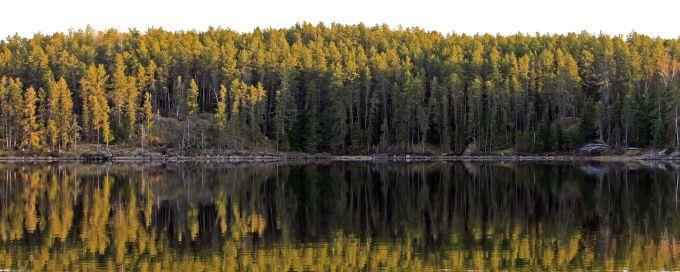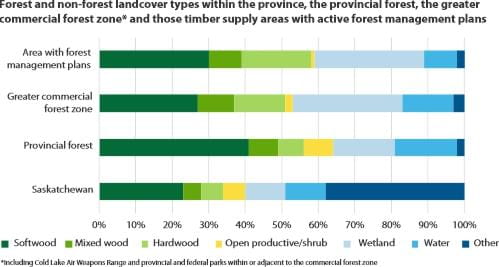
Why we measure this
Healthy forests provide many benefits, such as clean air, fresh water, healthy soils, habitat for plants and animals, materials for building homes and paper products. Forest management is based on the idea that forests change over time, young trees grow until they reach maturity. During this time a forest may be cut for wood products, burn in wildfires, or continue growing until trees become old and fall over, or are killed by insects and disease.
Forest management plans are used by professional foresters to care for the forest. When trees are cut following these plans, the harvest is sustainable, meaning that forests and the good things they provide will always be there. In Saskatchewan's managed forests, there is a mix of different forest types, and there are more mature and older trees than would be expected naturally. Protecting forests from fires, insects and disease is one of the reasons why our forests are now older. As a result, tree cutting is needed to help the forests stay healthy
The type and age of forests are important factors to consider when managing Saskatchewan's natural resources. Aging forests are more vulnerable to wildfire, insects and disease. Forest management in Saskatchewan is designed to result in a forest age structure that emulates natural disturbance. By emulating natural disturbances, the natural range of ecosystems should be maintained, resulting in a more resilient system.
What is happening

The province of Saskatchewan covers an area of approximately 65.2 million hectares. The northern half of the province is largely covered by upland forests, wetlands and water. Grass and agricultural lands cover 36 per cent of the province, mainly in the south.
Four ecozones are found within the province: Taiga Shield, Boreal Shield, Boreal Plain and Prairie. The "provincial forest" is a region defined in The Forest Resources Management Act covering approximately 34 million hectares within the Taiga Shield, Boreal Shield and Boreal Plain ecozones.
About 64 per cent of the provincial forest is an upland forest (41 per cent softwood, eight per cent mixed wood, seven per cent hardwood, and eight per cent open productive/shrub forest types). Wetlands and water each account for 17 per cent of the provincial forest. Grass, barren rock/sand, agricultural and anthropogenic areas make up the remaining two per cent of the landcover.

*For the purposes of this indicator, the 11.7 million-hectare commercial forest zone has been expanded to include the Cold Lake Air Weapons Range, and provincial and national parks within and adjacent to the commercial forest zone. Within the provincial forest, the greatest amount of human activity occurs within this 14.3 million-hectare area referred to here as the greater commercial forest zone.
The greater commercial forest zone is largely softwood, but features a greater proportion of hardwood and mixed wood forest types compared to the provincial forest. Wetlands also feature prominently within the greater commercial forest zone, covering nearly a third of the area.
Most forest-based economic activity and fire suppression occurs within the greater commercial forest zone, which is subdivided into a number of timber supply areas. As of 2019, there are six active forest management plans, covering 8.3 million hectares.

Boreal forests, when uninfluenced by human activities, are shaped by natural disturbances such as wildfire, insects, disease and wind. In theory, the greatest amount of forest area is typically found in the youngest forest ages, and the least amount of forest area is typically found in the oldest forest ages. In contrast, forests managed solely to sustain timber yield are evenly distributed among young, immature and mature forest ages with very little forest area in the old and very old forest ages. The greater commercial forest zone's current forest age structure falls between these two theoretical patterns.
Where humans have been putting out wildfires for decades, the forest has become older than it would under natural boreal forest conditions. This can lead to more intense wildfires and more serious insect infestations. Letting wildfire play its natural role when safe and feasible is one way to address this age imbalance; carefully planned forest harvesting can be another.
Native plant and animal species are often associated with certain forest and wetland types and certain forest ages. The availability of habitat for various species may be partially assessed through the abundance and distribution of forest types, forest ages and wetlands. Maintaining the natural range of ecosystems results in a more resilient system, helping to sustain overall biological diversity. Ecosystem diversity, the variety and relative abundance of ecosystems and their plant and animal communities, is necessary for species preservation.
The ideal distribution of forest ages for any management area depends on the ecology and management goals for that area. In reality, the target forest age structure is somewhere in between the natural pattern and that of a forest managed solely for timber. What is important is that wood fiber, habitat and ecosystems are maintained.

More detailed information can be found in this technical report.
What we are doing
Saskatchewan's forest management planning process emulates natural disturbances – unlike a sustained timber yield approach – allowing ecosystems to be maintained, resulting in a more resilient system. Resilient systems sustain biological diversity, protect habitat, maintain recreational opportunities and ensure economic growth.
Forests must be managed to balance habitat needs, recreational opportunities and economic growth. Like a well-diversified financial portfolio makes it easier to adapt to economic market changes, biological diversity makes it possible for ecosystems and species to respond and adapt to environmental change. Generally, forest management practices over the last several decades in Saskatchewan have shifted the distribution of forest ages towards older classes in the greater commercial forest zone.
